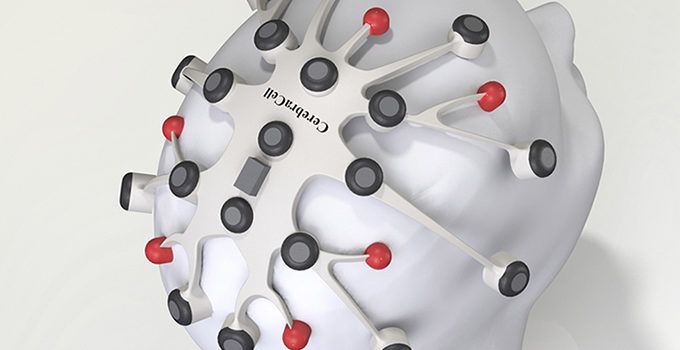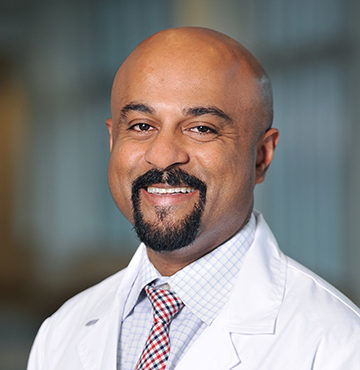

Bioelectric Therapy for Neurological Disease Treatment
by Zara Jethani
IMAGINING THE POSSIBILITIES
PNI’s Dr. Santosh Kesari is chief medical adviser for CerebraCell, which focuses on brain regeneration utilizing patented bioelectric signals that home stem cells to the brain and cause new blood vessels to grow.
By Lee Barnathan, California Business Journal
Imagine using electricity to non-invasively treat and cure brain cancer, stroke, or Parkinson’s. Or an aneurysm, Alzheimer’s, depression, or even a concussion.
Santosh Kesari, MD, PhD, is one of many people who see the possibilities in the world of alternating electric field therapy.
“Within two years, I think we can start trials,” says the chief medical adviser for CerebraCell, a company devoted to using bioelectrical stimulation to treat a cure for various brain injuries, conditions and diseases.
Delivering Bioelectric Therapy
CerebraCell’s method of delivering such stimulation is a “brain helmet,” an apparatus made of plastic with numerous electrodes that zap the brain with the right amount of electrical pulses to stimulate the necessary repairs, whether by triggering adult stem cells, causing new neuron pathways to fire, or sending messages for the cell to repair itself.

“We are electrical beings,” Kesari says. “Every cell in our body has charges. The nervous system works on electricity. Electricity is being generated all day, every day, or else you won’t live.”
And the effects of electricity on the body are well known and go beyond Robert O. Becker’s 1985 book “The Body Electric,” in which he theorized that electric fields play a role in regeneration. As far back as 46 AD, Scribonius Largus, physician to Roman Emperor Claudius, used electric fishes to treat headaches.
In 1804, Giovanni Aldini performed electrical stimulations on the exposed human cerebral cortex of recently decapitated prisoners and concluded the cortical surface could be electronically stimulated. The introduction of electroshock therapy in 1938 further demonstrated therapeutic applications of stimulating the brain.
But Kesari, who is also the director of the Santa Monica-based Pacific Neuroscience Research Center at Pacific Neuroscience Institute, says electroshock differs in that it uses high voltage of electricity.
CerebraCell’s brain helmet uses lower voltages. What Kesari and other researchers are trying to determine, he says, is to find the specific electrical current that will start the healing process, and then use the brain helmet to deliver that current.
Building on Past Experience
What’s not yet known is whether each condition would have is own current. Will researchers find one current that would work for all conditions? Or will each individual require his or her own current that would only work for him or her?
The process is moving forward. The Food and Drug Administration in 2016 approved the Israeli company Novocure’s treatment for newly diagnosed or recurrent glioblastoma multiforme (GBM), an aggressive brain cancer.
Novocure created a series of four portable patches one wears on the scalp. Through a connected battery, the product, called Optune, delivers the right amount of electricity to the tumors (the Optune website says chemotherapy is sometimes needed as well).
Kesari worked on the Optune trials, so he believes in the technology.
“If you have brain damage or Alzheimer’s or trauma, you’re missing some growth factor,” he says. “The idea is to stimulate the growth factor.”
Dr. Warren Merrifield, the Chief Technology Officer of CerebraCell, could not be more elated “to have the opportunity to work with Dr. Santosh Kesari. He is one the most renowned scientists in neuroscience.”
Developing a Deeper Understanding of More Elusive Conditions
With many brain injuries and diseases, it’s easy to see where the problem lies. With a tumor, concussion or stroke, the tau protein that signifies Alzheimer’s and an aneurysm are physical manifestations, making them easy targets.
But what about issues associated with brain health such as depression and memory? Kesari says these are “neurotransmitter problems” that would require electrical signals to be sent into the frontal lobe (depression) and temporal lobes (memory). The trick is finding the right neurotransmitter in addition to the right amount of electricity.
What Kesari doesn’t have enough of yet is money. Funding is everything in the research game. Kesari says that if he had millions of dollars, “We could get it done in a year.”
“It’s like a startup,” he quickly adds. “It’s getting to the point to move forward to do studies and move into investigational device exemptions, and then trials.”
The first study planned would be a safety and exploratory study of between 10 and 30 subjects.
“Once we see what the signals are, we use that information to build a bigger study,” he says.
CerebraCell from Vimeo.
Combination Therapies Could Yield Greater Success
In 2016, a team from Stanford University published results with modified stem cells demonstrating the ability to restore a number of cerebral stroke patients that were wheelchair bound to begin walking again.
Dr. Kesari was an investigator in the follow-on Phase 2b Sunovion/Sanbio ischemic stroke study to that trial. “Our CerebraCell team is working to improve upon these results with the addition of bioelectric stimulation, repeat deliveries and loading the stem cells into a hydrogel gel matrix mix shock full of support agents and growth factors,” he says.
For advanced brain injury and stroke patients with significant severe damage, CerebraCell is also studying the combination of bioelectric stimulation with a re-fillable micro infusion that will delivery up to 2mls of the CC-15 component brain regeneration candidate composition comprised of stem cells, growth factors, amniotic fluid, PRF, exosomes, Micro RNAs, engineered hydrogel, selected alkaloids such as tetraharmine and brain matrix.
For more information, contact Dr. Kesari at neuro.oncology@jwci.org.
Adapted from original article published in July 10, 2018, California Business Journal
About the Author

Zara Jethani
Zara is the marketing director at Pacific Neuroscience Institute. Her background is in molecular genetics research and healthcare marketing. In addition, she is a graphic designer with more than 20 years experience in the healthcare, education and entertainment industries.
Last updated: May 6th, 2021